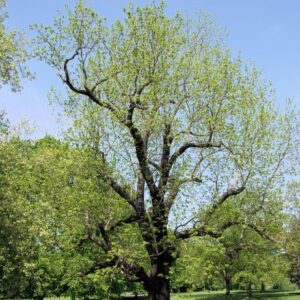Description
Ironwood Tree – 1 Yr Old Seedling
Overview
Ironwood (Ostrya virginiana), also known as Eastern Hophornbeam, is a slow-growing deciduous tree renowned for its incredibly dense and strong wood. This tree is ideal for landscapes where long-term, low-maintenance shade is desired. The Ironwood has distinctive, hop-like seed clusters, and its fall foliage turns golden yellow, adding vibrant color to your yard. This species is perfect for those seeking a tree with ecological benefits and year-round visual interest.
Ironwood Tree Native Range
Native to North America, Ironwood is found across the eastern United States and parts of Canada, typically growing in woodlands, forest edges, and upland areas.
Growth and Form
- Height: Grows approximately 12–18 inches per year, reaching 30–40 feet at maturity.
- Spread: Mature trees have a canopy spread of 25–35 feet.
- Growth Rate: Slow to moderate, making it ideal for long-term landscapes.
- Foliage: Glossy, dark green leaves that turn golden yellow in the fall.
- Bark: Smooth, grayish bark that becomes scaly and rough as the tree matures.
- Seeds: Produces distinctive hop-like seed clusters that hang from the branches.
Ecological Benefits
- Wildlife Habitat: The tree’s seeds are an important food source for birds and small mammals. The Ironwood also provides shelter for various wildlife species.
- Shade and Cooling: With its dense canopy, Ironwood is an excellent shade tree, perfect for reducing temperatures in urban and rural landscapes.
- Soil Health: Ironwood’s fallen leaves contribute organic material to the soil, promoting healthy ecosystems and plant life.
Ironwood Tree Hardiness and Climate Tolerance
- Hardiness Zones: 4–8, making it suitable for a wide range of climates, from colder northern areas to more temperate regions.
- Cold Tolerance: Tolerant of cold temperatures down to -30°F (-34°C), allowing it to thrive in regions with harsh winters.
- Drought Tolerance: Once established, Ironwood is drought-tolerant, though it benefits from regular watering when young.
- Soil Preferences: Prefers well-drained, sandy, or loamy soils but can adapt to a variety of soil types, including clay and slightly acidic soils.
Planting and Care
- Planting Location: Prefers full sun to partial shade. Plant in an area with space to accommodate its slow-growing nature.
- Watering: Water regularly during dry spells, especially in the first few years. Once established, the tree requires less frequent watering.
- Fertilization: Ironwood benefits from light, balanced fertilization in its early growth stages.
- Pruning: Minimal pruning required. Remove dead or damaged branches in late winter or early spring to maintain the tree’s shape.
Uses
- Timber: The strong, dense wood is highly valued in woodworking and used for tool handles, furniture, and other durable products.
- Shade and Landscaping: Ironwood is a popular choice for shaded areas, offering long-term growth and aesthetic appeal.
- Wildlife: The tree’s seeds support local wildlife, making it an excellent choice for wildlife-friendly landscapes.
Potential Problems
- Pests and Diseases: Ironwood can be susceptible to pests such as aphids and scale insects. Regular monitoring and care can prevent significant damage.
- Slow Growth: Due to its slow growth rate, Ironwood may take several years to reach full size, which may be a consideration for those looking for faster results.
- Competing Roots: As with other large trees, avoid planting Ironwood too close to other trees to prevent root competition.







Reviews
There are no reviews yet.